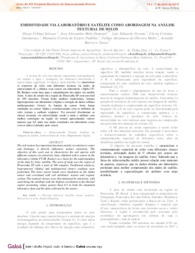Emissividade via laboratório e satélite como abordagem na análise textural de solos.
Emissividade via laboratório e satélite como abordagem na análise textural de solos.
Authorship: SALAZAR, D. U.; DEMATTÊ, J. A. M.; VICENTE, L. E.; GUIMARAES, C. C.; PADILHA, M. C. de C.; MELLO, F. A. de O.; SOUZA, A. B.
Summary: Resumo: A textura do solo tem funções importantes principalmente em relação a água e drenagem, ela influencia diretamente a emissividade superficial. O objetivo deste trabalho foi caracterizar os espectros de solos com diferentes texturas via dados de emissividade (?), obtidos com sensor em laboratório (Alpha FTIR, Bruker) como base para o entendimento dos dados via satélite Aster. A área de estudo foi a região de Piracicaba SP com um total de 190 amostras. Foram feitas análises tradicionais, leituras hiperespectrais em laboratório (Alpha) e extração de dados orbitais multiespectrais (Aster). As bandas do sensor Aster foram simuladas no sensor Alpha e correlacionadas com os atributos de solo: textura e carbono orgânico. Foi possível discriminar as classes texturais via emissividade, sendo a areia o atributo com melhor correlação na região do termal apresentando valores maiores que 0,5 tanto nos dados simulados em laboratório como com os dados coletados pelo sensor. ? Abstract: The soil texture has important functions mainly in relation to water and drainage, it directly influences surface emissivity. The objective of this work was to characterize the soil spectra with different textures via emissivity data, obtained with a sensor in the laboratory (Alpha FT-IR, Bruker) as a basis for the understanding of the data by Aster satellite. The area of study was the region of Piracicaba SP with a total of 190 samples. Traditional analyzes, hyperspectral (Alpha) and multispectral (Aster) readings were performed. The Aster sensor bands were simulated on the Alpha sensor and correlated with soil attributes: texture and organic carbon. The textural classes were discriminated by emissivity, with sand being the attribute with the highest correlation in the thermal region presenting values greater than 0,5 in both the simulated laboratory data and the data collected by the sensor.
Publication year: 2019
Types of publication: Artigo em anais e proceedings
Unit: Embrapa Environment
Observation
Some of Embrapa's publications are published as ePub files. To read them, use or download one of the following free software options to your computer or mobile device. Android: Google Play Books; IOS: iBooks; Windows and Linux: Calibre.
Access other publications
Access the Agricultural Research Database (BDPA) to consult Embrapa's full library collection and records.
Visit Embrapa Bookstore to purchase books and other publications sold by Embrapa.

